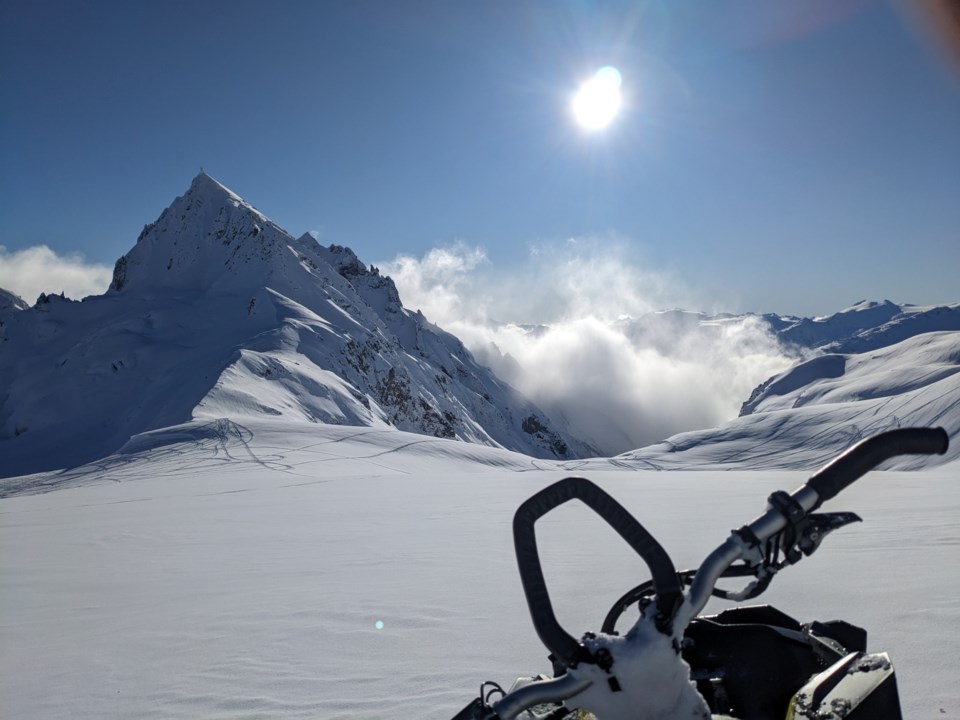This season marks my fourth as a bonafide snowmobiler. In March of 2022 I addressed my motivations for entering this loud, expensive but incredibly fun sport. At the top of the list was the ever-increasing crowding at ski-touring trailheads and backcountry access zones. The Spearhead access via Blackcomb Glacier has been busy for years, but now the recessed glacier has made it a double-black-style entrance, forming quite the bottleneck on a sunny Saturday.
The Sea to Sky winter trailhead—and ski-touring in general—looks very different from where it was even 10 years ago, and solitude is increasingly hard to find. Sledding can have busy parking lots, too, but once you reach the alpine, it’s quite easy for you and your friends to simply point your sleds in another direction and go find your own place to play in.
The second big reason for me defecting to the two-stroke club was exploration. After 15 years of ski-touring in the Sea to Sky, I had set foot in most of the accessible mountain ranges. When I finally made it to the Pemberton Icecap last season, I understood where sleds can really take you. Peaks and glaciers as far as the eye can see, only limited by how many hours of daylight you have and how much extra octane 91 you packed in. Then you have all the other logging road access points sprinkled up and down the corridor, each with its own unique character of terrain for skiing and sledding. Since moving to motorized access, I’m seeing mountains I never knew existed.
The third reason is linked to the first reason; I have a full-time job now that requires me to work Monday to Friday. I do miss my quiet, mid-week pow days on the hill as much as anyone would and I envy those who can structure their backcountry skiing around the week’s weather patterns. But you know what I don’t miss? Being too broke to afford and maintain a sled and a truck. Unless snowmobiling is the only thing you spend your money on, you’re going to need a steady income to fund this rather costly hobby.
All valid reasons to invest the time, money and effort into a 165-horsepower backcountry access tool. But the hardest thing about sledding wasn’t the expense or all the logistical hassle, it was staying motivated when my days of sledding got tough.
Like a lot of sports, not everyone becomes a lifelong participant of snowmobiling. Some folks may not gel with the culture, they may get sick of the noise two-stroke motors make or just get frustrated with how difficult it can be to learn to ride in powder. Plenty of sled-curious folks throw the towel in after a couple of years and go back to ski-touring or lapping the resort.
My first two years of sledding I was super picky about what days I would go out. Conditions had to have good visibility with snow that wasn’t too deep, lest I spend all my time digging and deadlifting my machine out of holes (sleds are great at digging their own graves). While I had some great days cruising on sunny glaciers and learning to carve my machine, I wasn’t learning the real sledding—entering deep snow, getting stuck and problem-solving how to get unstuck with the least amount of manual labour. Since I started braving the real pow days on my sled, I’ve learned from my friends how to leverage the power of my machine to get myself out, how to sidehill to more safely access better terrain and how to turn this 345-centimetre-long behemoth around in very little space and avoid the disaster of it rolling into a creek or ravine.
The culmination of this hard-earned experience paid off on a day in the Brandywine zone back in early December. Early conditions were shaping up well, but the groomed access to the alpine via Chocolate Bowl was still a good month away. Sledders wanting to access the alpine in this zone have two options: brave the complex climb up an ungroomed Chocolate Bowl, passing through an exposed area known as Avalanche Alley, or climb up the Gauntlet from Brandywine Meadows, a steep and committing climb with rock hazards.
I had my anxieties about tackling the gauntlet. Did I possess both the skill and moxie to make it up? Getting stuck near the top or losing momentum on the steepest section can mean a complicated retrieval, or worse, your sled rolling back down the gauntlet and causing costly damage along the way.
“Keep your weight all the way forward, like you’re humping the bars,” advised my friend Andy before I saw him demonstrate the climb. “And do not stop giving it gas.”
Cresting over the final pitch of the gauntlet to relative safety, my friend and another group of sledders looking on and pumping their fists in encouragement was a watershed moment in my snowmobile journey. I worked at the skill. I put in the time. And most of all, I turned towards the fear and pinned it.
There’s no feeling in the mountains quite like it.
Vince Shuley is readying his sled for tomorrow’s adventure. For questions, comments or suggestions for The Outsider, email [email protected] or Instagram @whis_vince.




